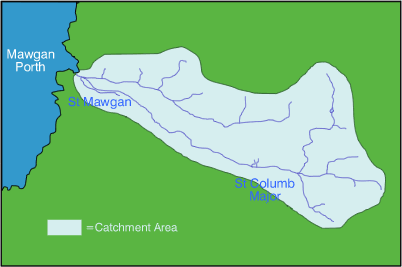River Catchments
- MENALHYL
The Menalhyl River rises on Borlasevath and Retallack Moor Sites of Special Scientific Interest and flows for 12 miles before entering the sea at Mawgan Porth; it principally consists of a main channel which rises to the east of St Columb Major and a tributary which drains the north of the catchment. The two river sections then meet at Mawgan Porth shortly before discharging into the Atlantic. The Moors are designated as SSSIs owing to the important wet heath plant communities situated around the headwaters of the Menalhyl, and the lower reaches of the catchment are designated as the Watergate and Laherne Area of Great Landscape Value (AGLV).
Moor grasses and Black Bog Rush, Schoenus nigricans, are found throughout the range of heaths, grasslands, scrubland and open water of the site. Other rarer rushes can be found, alongside Sphagnum mosses, sundews and Grey Willow Salix cinera. These communities support amphibians, dragonflies, Hen Harriers, Circus cyaneus, and a range of warblers.
The catchment is underlain primarily by Devonian calcareous slates, grits and limestone. Owing to low permeability, rainfall results in rapid run-off and therefore stream levels rise quickly after rain. Throughout the freshwater sections of the catchment, brown and sea trout, lamprey, eel, minnow and three spined stickleback have been recorded.
Impacts on the Menalhyl are known to arise from storm sewer overflows in St Columb, general agricultural diffuse pollution and biological monitoring of the river indicates poor water quality in this area. The majority of the stream is vulnerable to becoming eutrophic. Failures have occurred in the Mawgan Porth bathing water.
Land management within the catchment is still predominantly agricultural although tourism is becoming increasingly significant. Twenty seven farms have been visited as part of CRP covering an area of 1,813 hectares and 26km of Streambank have been surveyed. The main agricultural activities are beef and sheep farming and the cultivation of vegetables and arable crops such as wheat, barley and maize. Many farms are also diversifying incomes through enterprises such as holiday lets, B&Bs, riding stables and campsites. Several farms within catchment are in Environmental Stewardship agreements owing to the area’s proximity to the coastal Stewardship target area and some are also in the Woodland Grant Scheme.
Much of the advice given through CRP has focused on reducing the effects of agricultural diffuse pollution in the catchment through improved nutrient and soil management. Additional advice has also included the identification of diversification opportunities into tourism due to the popularity of the area with visitors, particularly around Mawgan Porth.
